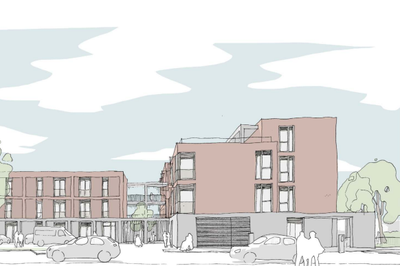Bishops Waltham Fire Station
The town of Bishops Waltham is in the Hampshire Countryside and was home to the original Bishops Waltham Fire Station (BWFS). This station had been a key staple within the village since the 1960s, however, after many years, it had reached the end of its serviceable life and needed major restoration works. A demolition and rebuild provided the most appropriate and efficient solution.
Key Stats
- New build improved and modernised station
- new tower and training facilities on existing site
- Fabric first approach providing an energy efficient building
- Completed on time and on budget
- 45/45 CCS Score
At a Glance
Budget
£3 million
Completion
February 2023
Location
Bishops Waltham, Southampton
Framework
Southern Construction Framework (SCF)
Sector
Emergency Services, Blue Light
Social value
£2.3 million
Sustainability
92% Waste Diverted from Landfill
The need for a new Fire Station
As part of a wider £21m station investment programme for Hampshire and Isle of Wight Fire and Rescue Services (HIWFRS), BWFS is the first installation in the series of three. The previous Fire Station was demolished to make room for a new build station which includes a new training area and training tower with a roof transfer. The new training facility will be made usable for the surrounding fire stations once built. Other key features include: a gym to support firefighters in their fitness tests, and a conference room with inclusive, accessible facilities to support the community.
With the original concept designs provided by Hampshire County Council and a project team consisting of HLM Architects, Arup and HIWFRS, the project was completed on time and on budget.
Challenges faced on site
The previous station was in a flood risk zone which, through previous site investigations, revealed it to have a high-water table within a 50m radius of the station. To help prevent significant damage in the event of flooding occurring in the future, the team designed around this by relocating the building out of the main flooding zone and providing enhanced flood defences. Examples of the defences included the implementation of extra ducts to ensure a swifter decant of water.
The site set-up itself was compact and small which meant the team faced two key challenges: access to and from the site, along with storage of materials. Through implementing a robust traffic management plan, and where possible, avoiding driving directly through the village centre, the team were able to reduce noise and dust pollution in the village and ensure safety on the site. The team were also granted special access for the Piling Rig to get onto site. 'Just in time' deliveries were implemented which meant the need for plentiful set down space on site was reduced.
Providing an efficient building with a ‘Fabric First’ approach
The new facility was designed with a fabric first approach, meaning the emphasis was around improving and maximising the performance of the components and materials that make up the building fabric itself. The M&E factor would therefore become the secondary consideration. The project team were able to deliver on this by maximising the air tightness of the building through construction techniques such as wet two coat plastering and air ceiling paint in key areas such as behind roof joists. Other techniques pertinent to the fabric first approach included triple glazed windows and improved ventilation via the inclusion of Mechanical Ventilation Heat Recovery units (MVHR).
The building draws on many other sustainable features including a 22 solar panel farm on the roof of the building, Air Source Heat Pumps, and recycling waste as much as possible with helping divert 92% of waste away from landfill.

Handprint Hoarding
Key members of the team had a vision to include and embody the local community as much as possible within the project. The team came up with the idea of enlisting local infant school children to decorate the site hoarding with a design that was simple but effective. The team attended one of the school assemblies to ask for their help as well as informing them all about the new fire station being built in the town. After this, what started with a simple tree design was soon decorated with every single child's hand print. The hand print has become so popular to the extent that the fire service asked to have this put in the appliance bay.
Give and Gain Day - Sensory Garden
As part of our Give & Gain Days, we love to engage in our local communities by giving something back for them. The project team were enlisted with a mini project to create a new sensory garden for a local school. This project was first identified by Fire Fighter Andy Gussman who was instrumental in introducing us to the school and particularly Helen White, who had the idea and vision behind the project. In just a morning, we managed to clear an overgrown area to the back of the classrooms, cut back some of the over-hanging tree branches and created a new outdoor seating area surrounded by new flower beds for a range of sensory planting. We put up some bird boxes, bug and insect hotels, wind chimes and also planted two fruit trees which will not only increase the school's biodiversity but help reduce carbon by 1 tonne each over their 20-year lifespan.
We are committed to providing stations with modern and inclusive facilities for the benefit of our colleagues and the communities we’re so proud to serve.
We worked closely with Morgan Sindall Construction to ensure the new build met our estate design principles, and it’s exciting we are now able to officially open the station and look back on all the work that led us to this point.
The rebuild of Bishop’s Waltham Fire Station is part of our wider estates improvement programme, with upgrades planned at more stations across Hampshire and Isle of Wight and a brand new fire station at Cosham, set to become operational next year.”
Arron Hedges, Head of Properties and Facilities at Hampshire and Isle of Wight Fire and Rescue Service
Gallery
Related News
NEWS

Morgan Sindall Marks Steel Signing Milestone at Selly Oak SEN School
Morgan Sindall Construction has marked a significant milestone in the delivery of Selly Oak SEN School with a steel signing ceremony, celebrating the completion of the building's structural frame.
NEWS

Morgan Sindall celebrates topping out at Hexham Road care and residential scheme
Morgan Sindall Construction’s Thames Valley business has marked a major milestone in the development of the £21.9 million Hexham Road residential and adult care facility, celebrating the project’s topping …
NEWS

Stellar New Nursery at UKAEA’s Culham Science Campus
Morgan Sindall Construction’s Thames Valley team has successfully handed over Culham Science Centre Nursery & Preschool, a purpose-built early years facility located on the site of the UK …














